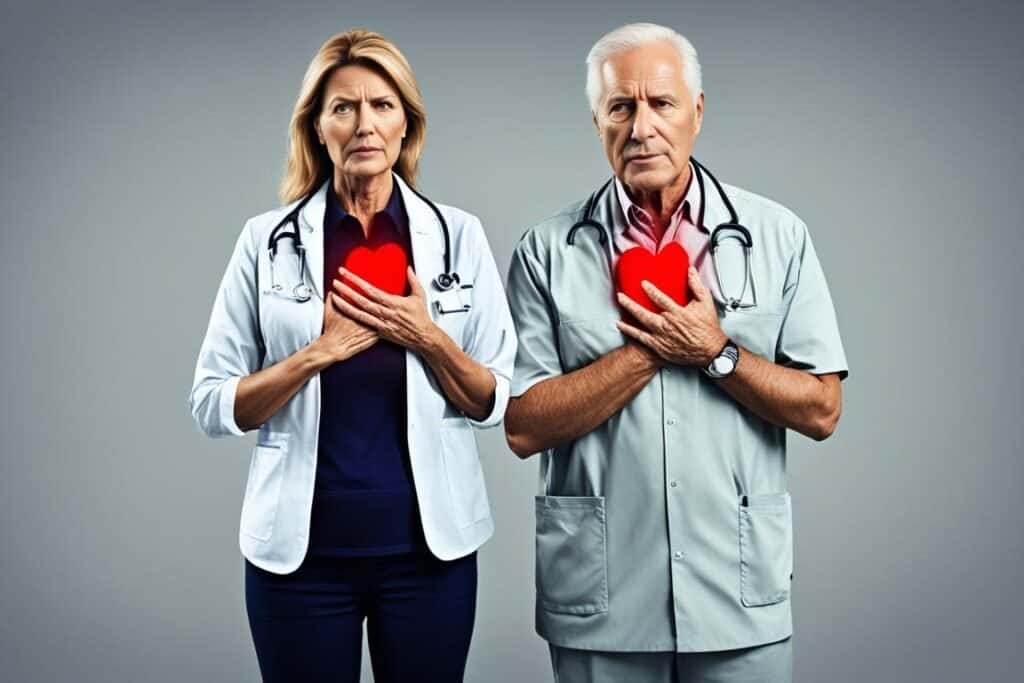When it comes to medical emergencies, recognizing the signs and symptoms can make all the difference. Two of the most serious conditions that require immediate attention are heart attacks and strokes. While they both involve a sudden disruption in blood flow, it’s important to understand the differences between them. By knowing the signs, you can act quickly and potentially save a life.
Key Takeaways:
- Heart attacks and strokes are both medical emergencies caused by a disruption in blood flow.
- Early signs of a heart attack may include chest pain, discomfort in the arms, back, neck, or jaw, and shortness of breath.
- Early symptoms of a stroke may include sudden headache, numbness or weakness on one side of the body, and confusion.
- In an emergency, call emergency services immediately and wait for paramedics to arrive.
- Heart attack symptoms often involve chest pain, while stroke symptoms can include sudden numbness or weakness.
- Women may experience atypical symptoms of a heart attack, such as flu-like body aches, while men commonly report chest pain.
- Timely treatment and a healthy lifestyle can improve outcomes after a heart attack, while stroke prognosis can be more challenging.
Early Warning Signs of a Heart Attack and Stroke
Recognizing the early warning signs of a heart attack and stroke is crucial for seeking immediate medical attention. While there are some overlapping symptoms, it’s essential to understand the distinct signs of each condition.
Heart Attack Symptoms
- Mild chest pain
- Discomfort in the arms, back, neck, or jaw
- Nausea or abdominal pain
- Dizziness or lightheadedness
- Shortness of breath
Stroke Symptoms
- Sudden headache
- Numbness or weakness on one side of the body
- Balance and walking problems
- Sudden confusion
- Swallowing difficulties
If you experience any of these symptoms, do not ignore them. Act quickly by calling emergency services or seeking medical assistance. Remember, early intervention can significantly improve treatment outcomes.

| Heart Attack Symptoms | Stroke Symptoms |
|---|---|
| Mild chest pain | Sudden headache |
| Discomfort in the arms, back, neck, or jaw | Numbness or weakness on one side of the body |
| Nausea or abdominal pain | Balance and walking problems |
| Dizziness or lightheadedness | Sudden confusion |
| Shortness of breath | Swallowing difficulties |
What to Do in an Emergency
In the event of a heart attack or stroke, it is crucial to call emergency services immediately. Time is of the essence when it comes to saving lives and minimizing damage. Here’s what you need to do:
1. Call Emergency Services
As soon as you suspect someone is experiencing a heart attack or stroke, dial emergency services right away. In India, the emergency number is 112. Provide as much information as possible about the situation and the person’s condition. Stay on the line until help arrives and follow their instructions.
2. Do Not Drive Yourself
It is important not to attempt to drive yourself or the affected person to the hospital. Emergency medical services have the necessary equipment and expertise to provide immediate treatment en route to the hospital. Driving yourself can delay treatment and put yourself and others at risk.
3. Wait for Paramedics
Stay with the person experiencing the medical emergency until paramedics arrive. Keep them calm and reassure them that help is on the way. Monitor their condition and be ready to provide any additional information when the paramedics arrive.
4. Chewing an Aspirin for a Heart Attack
If you suspect someone is having a heart attack and they are conscious, you can consider giving them aspirin if it is available. It is important to emphasize that this should only be done if they are able to chew and swallow without difficulty. Aspirin can help reduce blood clotting and may improve outcomes.
5. Note the Time for Stroke Treatment
In the case of a suspected stroke, it is crucial to note the time when the symptoms first began. Time is a critical factor in determining the appropriate treatment options for stroke patients. The exact time of symptom onset can help healthcare professionals make informed decisions about the best course of action.
6. CPR for Loss of Consciousness
If the person experiencing the heart attack or stroke loses consciousness and is not breathing, immediate cardiopulmonary resuscitation (CPR) may be necessary. If you are trained in CPR, start chest compressions and continue until help arrives. If you are not trained, the emergency services operator can guide you through the steps until paramedics arrive.
Remember, every second counts in a medical emergency. Taking the right steps and seeking immediate medical attention can significantly improve the chances of a positive outcome for individuals experiencing a heart attack or stroke.
Symptoms of Heart Attack vs. Stroke
Recognizing the symptoms of a heart attack or stroke is crucial for prompt medical attention. While there are similarities in the symptoms, there are also distinct differences that can help you differentiate between the two.
For strokes, common symptoms may include:
- Sudden numbness or weakness in the face, arm, or leg
- Difficulty speaking or understanding speech
- Vision problems
- Severe headache
On the other hand, common symptoms of a heart attack often involve:
- Chest pain or discomfort
- Radiating pain to the arms or shoulders
- Jaw or back pain
- Shortness of breath
It is important to note that both heart attack and stroke symptoms can vary from person to person. If you or someone you know experiences any of these symptoms, it is essential to seek immediate medical attention.
Signs of a Heart Attack and Stroke in Women and Men
Recognizing the signs and symptoms of a heart attack or stroke is essential for prompt medical attention. While some symptoms may be similar between men and women, there are also noticeable differences.
Heart Attack Symptoms
In men, chest pain is often the most common sign of a heart attack. It may feel like pressure or squeezing in the chest. Additional symptoms experienced by men may include:
- Upper body pain
- Shortness of breath
- Lightheadedness
- Nausea
- Cold sweats
On the other hand, women may experience atypical symptoms that are not typically associated with a heart attack. These symptoms can include:
- Lightheadedness
- Pain in the lower chest or upper abdomen
- Upper back pain
- Flu-like body aches
- Extreme fatigue
Stroke Symptoms
The signs of a stroke can be similar for both men and women. Common stroke symptoms include:
- Numbness or weakness on one side of the body
- Sudden difficulty speaking or understanding speech
- Vision problems
- Severe headache
However, women may also experience additional atypical symptoms during a stroke. These symptoms can include:
- Fainting
- Fatigue
- Incontinence
- Pain
- Overall body weakness
It’s important to note that these symptoms may vary from person to person. If you or someone you know experiences any of these signs, seek immediate medical attention.

| Heart Attack Symptoms | Stroke Symptoms | |
|---|---|---|
| Men |
|
|
| Women |
|
|
Heart Attack vs. Stroke: Prognosis and Complications
After experiencing a heart attack, timely medical treatment and adopting a healthy lifestyle can significantly improve your prognosis. Many heart attack survivors go on to live long and fulfilling lives with few reminders of their past cardiac event. However, the prognosis and complications following a stroke can be more complex and challenging to predict.
Complications that may arise after a stroke can have a significant impact on everyday life. Some common complications include:
- Walking difficulties: Strokes can affect your ability to coordinate movements and maintain balance, leading to challenges with walking.
- Swallowing problems: Stroke-related muscle weakness or coordination issues may result in difficulty swallowing, known as dysphagia.
- Reduced hand function: Weakness or paralysis in the hands and fingers can make it challenging to perform simple tasks like gripping objects or writing.
- Incontinence: Strokes can disrupt the brain signals involved in controlling the bladder and bowel, leading to problems with urinary or fecal incontinence.
- Cognitive impairment: Depending on the severity and location of the stroke, cognitive functions like memory, attention, and problem-solving may be compromised.
- Seizures: Some stroke survivors may experience seizures, which are sudden and uncontrolled electrical disturbances within the brain.
- Mood changes: Stroke can disrupt the brain’s emotional regulation, leading to emotional changes such as depression, anxiety, or mood swings.
- Musculoskeletal pain: Strokes can cause muscle stiffness, spasticity, or joint pain, which can impair mobility and overall comfort.
It’s important to note that the specific complications and their severity can vary from person to person depending on the type, location, and extent of the stroke. Rehabilitation programs, including physical therapy, speech therapy, and occupational therapy, can often help individuals regain lost functions and improve their quality of life.
| Heart Attack | Stroke | |
|---|---|---|
| Prognosis | If treated promptly and leading a healthy lifestyle, long-term prognosis is generally positive. | Prognosis can be more challenging to predict and may vary depending on the severity and location of the stroke. |
| Complications | Complications may include arrhythmias, heart failure, or myocardial rupture. | Complications may include walking difficulties, swallowing problems, reduced hand function, incontinence, cognitive impairment, seizures, mood changes, and musculoskeletal pain. |
It’s always important to work closely with healthcare professionals to manage any complications, follow recommended treatment plans, and make necessary lifestyle changes to improve overall well-being and reduce the risk of future cardiovascular or cerebrovascular events.
Conclusion
In conclusion, recognizing the signs and symptoms of a heart attack or stroke and seeking immediate medical attention is crucial for minimizing damage and improving outcomes. Both heart attack and stroke are medical emergencies that require prompt care. By understanding the differences between the two conditions, you can respond appropriately in an emergency situation, potentially saving lives.
Remember, if you or someone around you experiences symptoms of a heart attack or stroke, don’t hesitate to call 911 or the emergency services in your country. Stay calm and provide the necessary information to the operator. Follow their instructions while waiting for medical help to arrive. Early intervention can make a significant difference in the outcome of these serious medical events.
Lastly, it is essential to prioritize your health and adopt a healthy lifestyle to reduce the risk of heart attack and stroke. Regular exercise, a balanced diet, quitting smoking, managing stress, and maintaining a healthy weight can all contribute to a healthy heart and a reduced likelihood of cardiovascular events. Remember, prevention is always better than cure.

